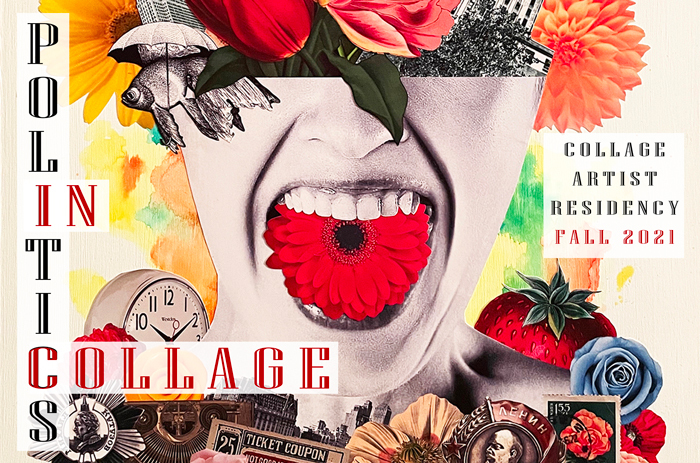
COLLAGE RESIDENCY
Kolaj Institute Announces a Second Round of Artists Selected for the Politics in Collage Residency
Kolaj Institute is pleased to announce the thirteen artists selected to participate in the second round of the Politics in Collage Residency.
Collage as a political art form has a particular relevance to today as well as a strong historical context. From its roots in the European anti-facist and Russian revolutionary movements in the early 20th century to its expressions during the U.S. Civil Rights era to its current manifestations in the fight for social justice in South America, collage is used by artists around the world as an impetus for social and political change.
In four virtual meetings over four weeks and through ongoing, online discussion, artists will examine contemporary social and political issues as shown through collage. Artists will hear from a variety of guest speakers about the historical context of this genre; how to articulate complex political subjects both in their work and in promotions of their work; and explore how we can continue to inspire meaningful engagement with difficult topics through collage.
Artists in the residency will conceptualize and begin work on a piece exploring a political or social subject of their choosing. Although the works may not be completed by the end of the residency, they will be regularly critiqued and discussed by the group throughout. Artists will write an artist statement that documents and provides critical context for their work. The completed work and texts from the residency will result in a book published by Kolaj Institute and an exhibition, whether in-person or online, to be determined at a later date.
G.E. Vogt will be leading the residency, shedding light on her own work as a political collage artist, as well as moderating discussions and sharing resources with artists. Ginger Sedlarova will speak about Friedl Dicker-Brandeis, an Austrian-born Jewish artist who successfully worked in a variety of mediums, including her agitprop photomontages in response to the rise of the Nazi movement in Austria and Germany, but may be best known for teaching art to the children in Terezin. John J Heartfield will discuss the history of his grandfather, John Heartfield, and how his work was not only a crucial part of the resistance to fascism in World War II, but is still impactful in today’s world. Wendy Parker will take the artists through a broad history of political collage, how it has engaged with and influenced different socio-political movements. Teri Henderson will speak on curating political collage in the contemporary art world, overcoming the challenges of doing so by creating new spaces for artists to be heard. Liucija Dervinytė will use her experiences as a collage artist, gallery owner, and creative space director to discuss the practical aspects of working as a political collage artist.
The goal of this residency is to help collage artists who are creating social/political work, or interested in doing so, to grow and expand their practice. By the end of the residency, the participants will be able to practically apply to their own work what they have learned from lectures and discussions with historians, curators, and working artists.
PARTICIPATING ARTISTS
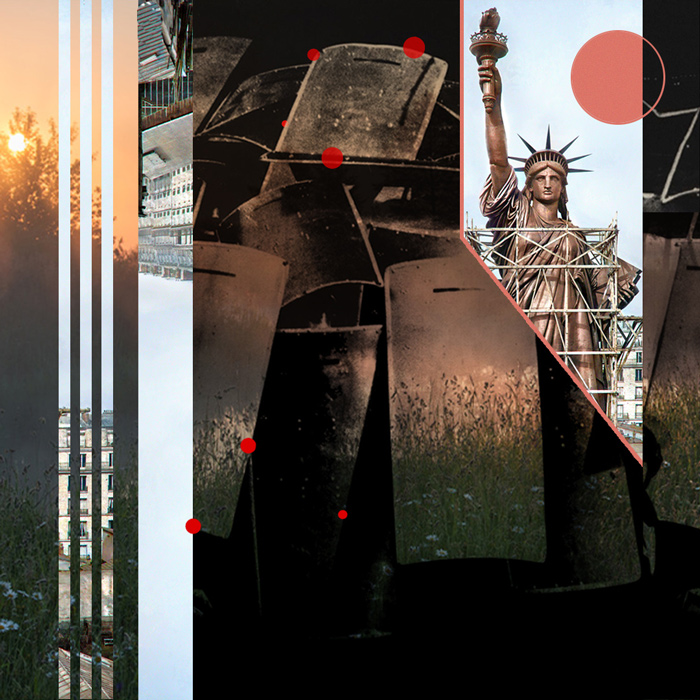
digital collage; 2020. Courtesy of the artist.
Alexander Helmintoller is a self-taught California-based collage artist, writer, and graphic designer whose emerging body of work explores themes of nationalism, betrayal, and renewal across generations through critique of Post War American Mythology. Their work also explores the early 20th century displacement of Jewish families as a result of pogroms in Eastern Europe. Elements of bureaucracy and statehood are represented in various forms; junk mail, advertisements, and architecture blur with the personal and are juxtaposed with suggestions of violence and complicity. Helmintoller has had work exhibited by the Vayo Collage Gallery in Rochester, New York, and is currently developing a collage series using a photo archive and chronicle of the Lithuanian shtetl his family is from.
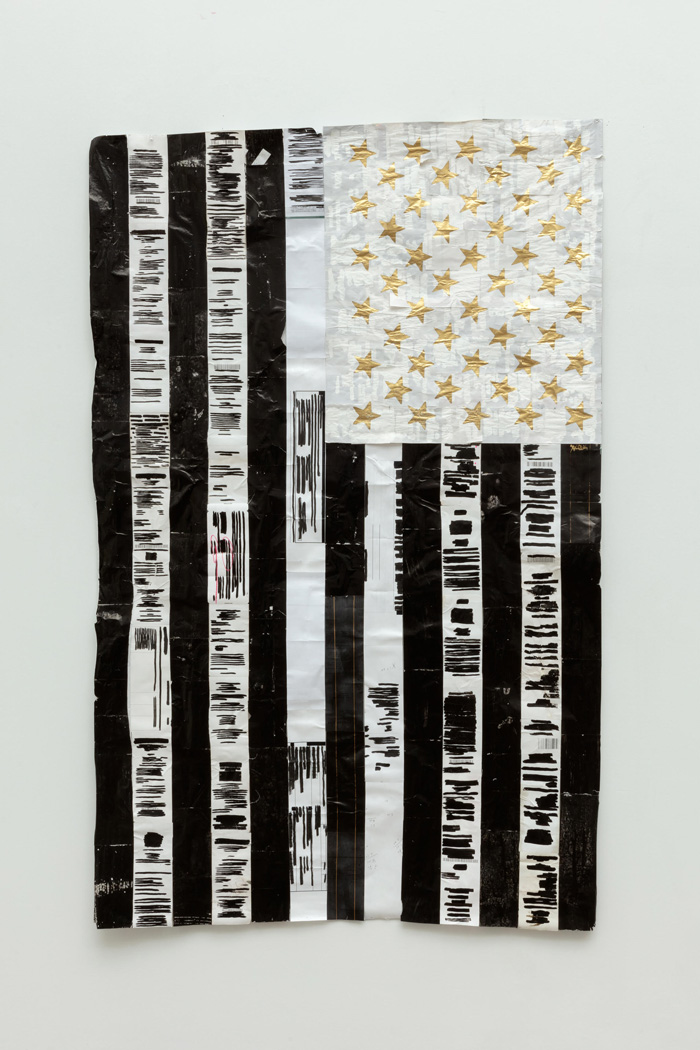
60″x36″; paper, acrylic, Sumi ink, watercolor, tape, glue; 2021. Courtesy of the artist.
Xxavier Edward Carter (born 1986, Dallas, Texas) is a transdisciplinary artist with a BFA from Stanford University and an MFA from Southern Methodist University. His work is presented as videos, publications, installations, and performances to encompass multi-sensorial and layered circumstances encountered by the artist. Personal interactions, media bombardment, observed and lived experiences, and material excess/waste influence his work towards a complex revolutionary promise. These are ecologically centered works often heavily linked to the material history of currency in how it relates to the histories of marginalized people. Carter is of Black and Native American heritage and views his work as a continuation of the survival and storytelling practices of these cultures. More broadly, he is interested in how these practices have analogies across cultures worldwide. Stories of origins, the afterlife, superhuman beings, and of love and tragedy are the most compelling for him. Carter creates work dealing with what these stories mean in an often violent and oppressive context and the power they have toward influencing revolutionary momentum.
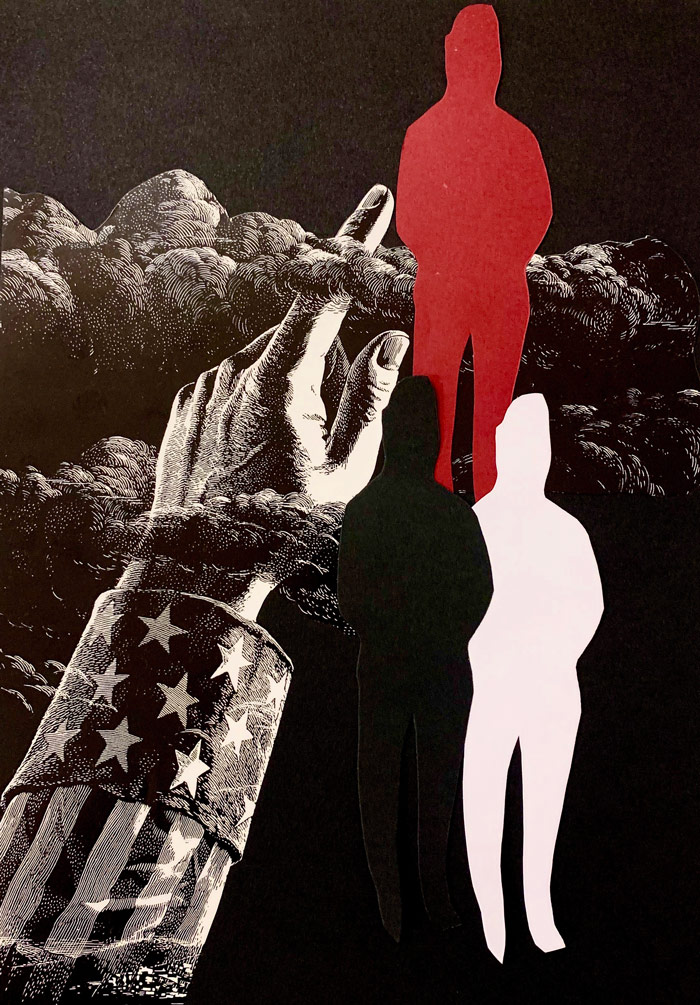
11.75″x8.25″; analog collage; 2021. Courtesy of the artist.
Patricia Figueiredo is a visual artist, whose main research theme is the emptiness created by the losses and pain inherent to human beings. Through analog collage, where physical contact with figures and scissors are present, she creates a connection with the images used in her works. Having Dadaism as a reference and base, where freedom of composition has always been present, she manipulates the chosen elements, through the infinite possibilities they present in the constructions and interpretations of new realities. The artist has exhibited her work since 2015 in several galleries around the world, such as NY, Milan, Venice, France, Spain, Berlin, Sweden, Finland and Brazil. In 2020 her work on the Dadaismo won second place in the competition held by the Brazilian Collage Society. In 2021 she was selected for several virtual exhibitions in London, participated in the telephone gallery, had her pink and blue collage selected for Every Woman Biennial exhibited at Copeland Gallery in London and virtually at Superchief gallery NY with her first work in NFT. Figueiredo was selected for a 3 month residency in Bulgaria, Sofia in 2020. In 2019, her work transbordar was selected for VeniceLand ArtPrize in Venice.
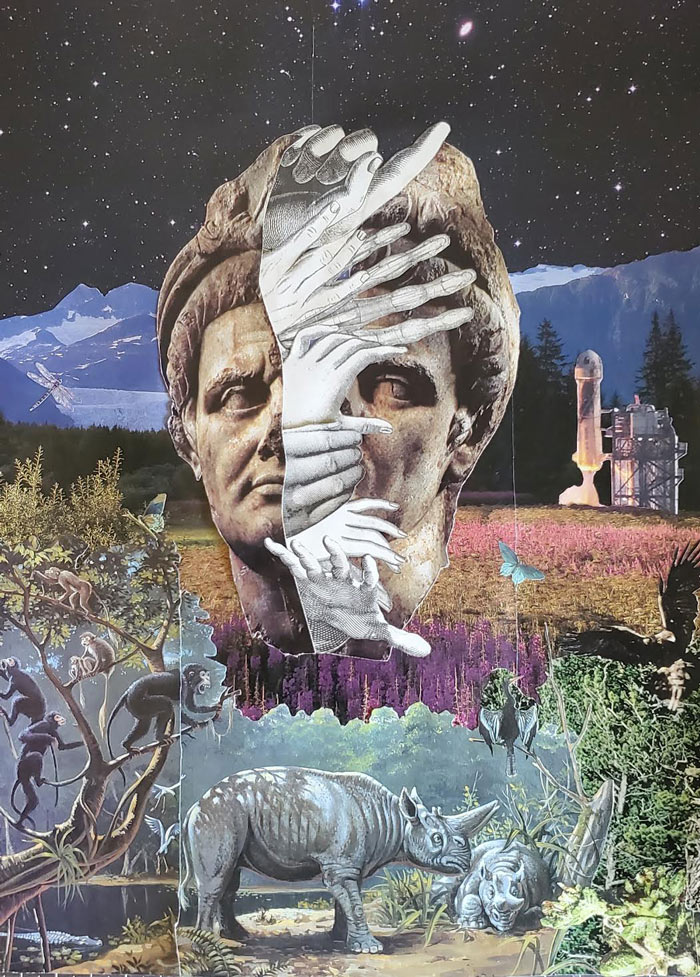
paper collage; 2021. Courtesy of the artist.
Lilith Frakes is a student and artist from Western Pennsylvania, currently living and studying in Washington State. With undergraduate degrees in Comparative Literature and Anthropology, she is currently pursuing a MSc in Primate Behavior. Despite a lifelong interest in destroying and reassembling images, Frakes’s self taught collages started in earnest after a yearlong course in philosophy in university, when visualizing complicated ideas through analog collage seemed to naturally compliment otherwise dense texts. Her collages have been featured in several undergraduate publications, including three cover images for fine art and anthropology magazines. Frakes’s work is inspired by themes of decolonization, environmental justice, inequality, and psychoanalysis.
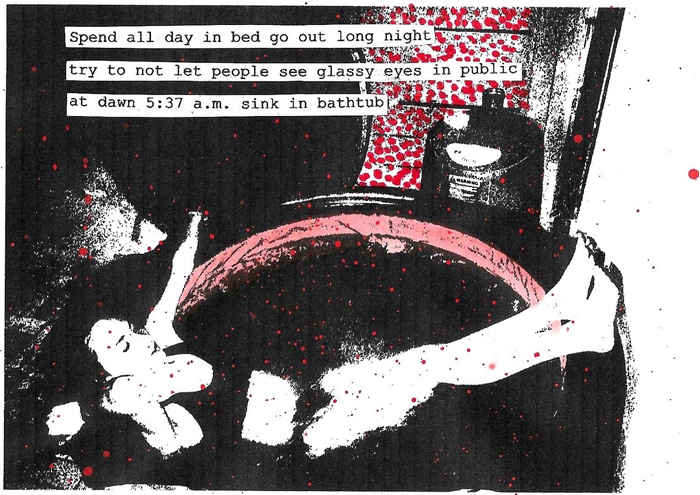
5″x8″; ink, glue, paper, gouache, scanner; 2018. Courtesy of the artist.
Jenn Arras is a text-based artist and musician based in New York City. She studied photography and creative writing with an emphasis in poetry at Columbia College Chicago and has interned with Graywolf Press. Inspired by the Punk DIY aesthetic, her work has been published as a zine called PSYCHOSEXUAL and animated into video. She currently works as a freelancer in the publishing industry and continues her education through online graphic design and mixed media courses.
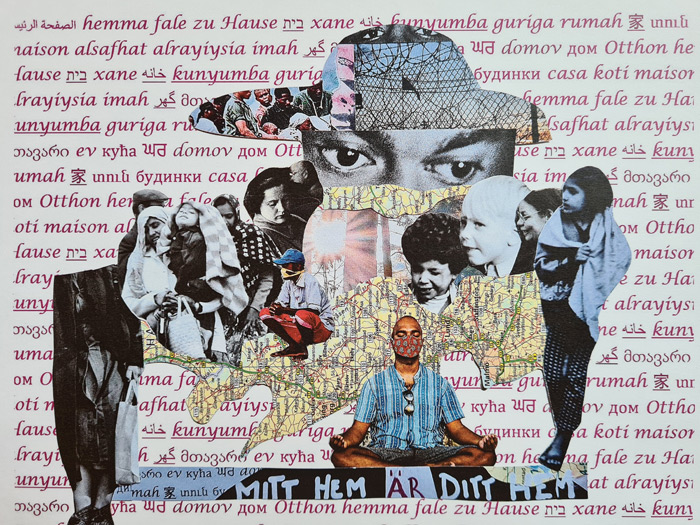
8.5″x11.5″; collage on paper; 2021. Courtesy of the artist.
Simone Löhndorf is a South Africa born, Swedish/German collage artist and cognitive linguist concerned with meaning making, both from the perspective of the artist and the viewer, the speaker and the hearer. Most things that meet our eyes and ears are conventionalized messages, which do not require much conscious effort on our part to interpret. Taking concepts out of their conventional context and intentionally or unintentionally create unexpected meanings, to draw attention to unconventional, yet highly meaningful content, Löhndorf believes, is one of the purposes of Art. Collage seems to be especially well suited for this purpose, since concepts can be reinforced by the choice of texture, origin, and time period when the material was created. In her collages, Löhndorf often focuses on human experience and human emotion. Collage making is a highly intuitive process for her, where she plays around with juxtaposing contrasting elements. Sometimes the meanings created are funny, sometimes serious, and often political. More and more often, they are found on the streets. Excited by street art from a young age, Löhndorf has recently realized that taking her collages to the streets is a way to spread her message of wanting to create a tolerant society and, furthermore, to let her collages engage with the eyes of curious passersby. Löhndorf was accepted for Kolaj Institute’s Collage as Street Art Residency in the summer of 2021 and is part of the resulting #kolajstreetkrewe. Three of Löhndorf’s collages are part of the Kanyer Collage Art Collection.
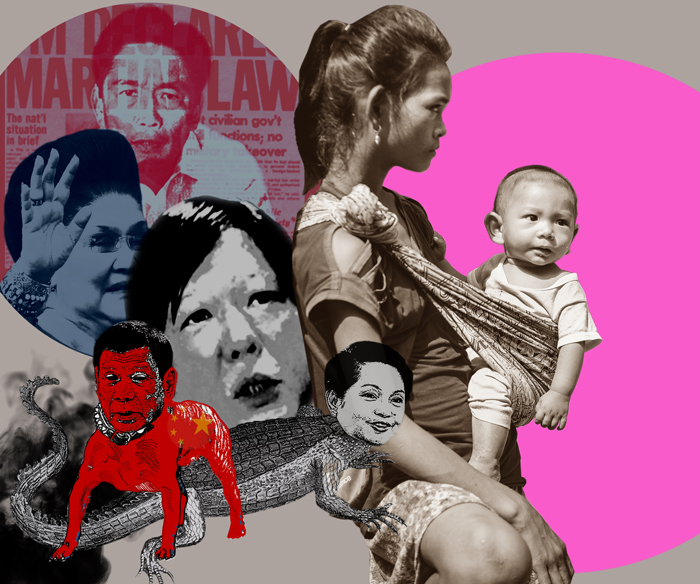
digital collage; 2021. Courtesy of the artist.
Carmen Angela Yandoc is a collage and mixed media artist based in the Philippines. She took to drawing and painting at an early age, her curiosity and inclination encouraged by the constant supply of art materials and the free rein to do as she pleased. That same curiosity and her love for nature steered her towards an academic degree in the biological sciences. Nevertheless, this delightful early experience cemented her lifelong love for the arts and commitment to the creative process. Through the years she made art using watercolors and added acrylics and oils to her repertoire. She started to make collages for a brief period in 2019 and when the pandemic fell upon us in 2020 she turned to collage full time. She soon found herself engaging in the online collage community which provided new opportunities. Her first collages were included in the Collage Garden Cartagena 2019 in Colombia and her work was selected and shown in a group show in Portland Oregon. Her work was also included in the Commission on Human Rights Gender Equality and Women’s Human Rights Center online exhibit in the Philippines. Carmen’s work has been published in Artist Talk Magazine and will be featured in Art Folio 2022. Her work has been featured in the online platforms of collage collectives in different countries. She creates collages that may be described as evocative, narrative or simply decorative but she also plans to make more art that takes a critical view of social and political issues.
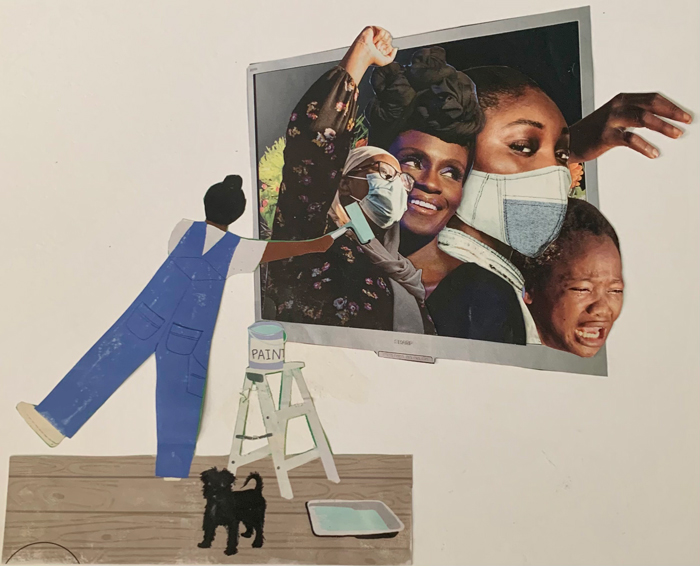
9″x12″; mixed media collage on paper; 2021. Courtesy of the artist.
Mori Anderson Hitchcock (born 1993) is a Black, queer, and nonbinary, analog and digital collage artist from Chester, Pennsylvania with familial roots in Cleveland, Georgia, and Jamaica. In college (2012-2017), they became a student of art history and criticism, where they first encountered the work of artists like Hannah Hoch, Basquiat, Carrie Mae Weems, and Magritte. However, most of their knowledge of what is possible with collage comes from various Youtube channels and Instagram pages devoted to the practice; as well as some private research done on the history of Black art that helped them learn about the legacy of Black collage artists. They began experimenting with collage in July 2019, but it wasn’t until November 2020, after the early stages of the pandemic, where they started to figure out what they wanted to do and began creating art to express the emotions that were beginning to consume them. Mori was intrigued by the fact that collage work reveals that Time and Space are fungible and they use the medium to highlight the transcendent beauty of Black people/Black history across the diaspora. Since starting, they’ve had several hundred-dollar commissions. One of their pieces (Get Out, 2021) will be up for auction to benefit an intentional community in Western Massachusetts and their work is being featured in an anthology on Black Collage art. This would be their first opportunity to develop their skills in a professional setting with other collage artists and scholars.
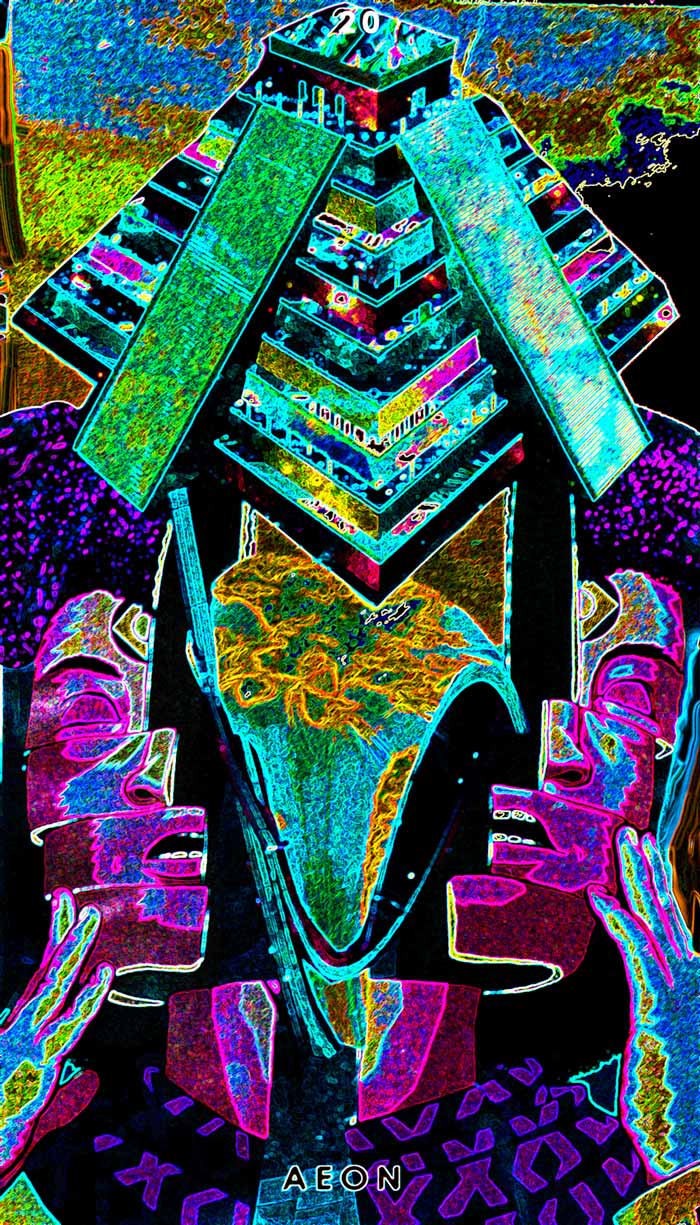
4.75″x2.75″; mixed media collage (magazine, books, calendar, wallpaper,
modpodge) digitally altered; 2014. Courtesy of the artist.
Casey Rocheteau is a multidisciplinary artist. They were the recipient of the inaugural Write A House permanent residency in Detroit. They are a 2021 Kresge Arts in Detroit Fellow. They have attended Callaloo Writer’s Workshop, Cave Canem, and Bread Loaf Writers’ Conference. They are the creator of the Shrine of the Black Medusa Tarot, a collage tarot deck. Their second collection of poetry, The Dozen, was published on Sibling Rivalry Press in 2016. They are one of the founders of the Fortify Writers Retreat in Detroit, and the director of the Hotel Atlantis.
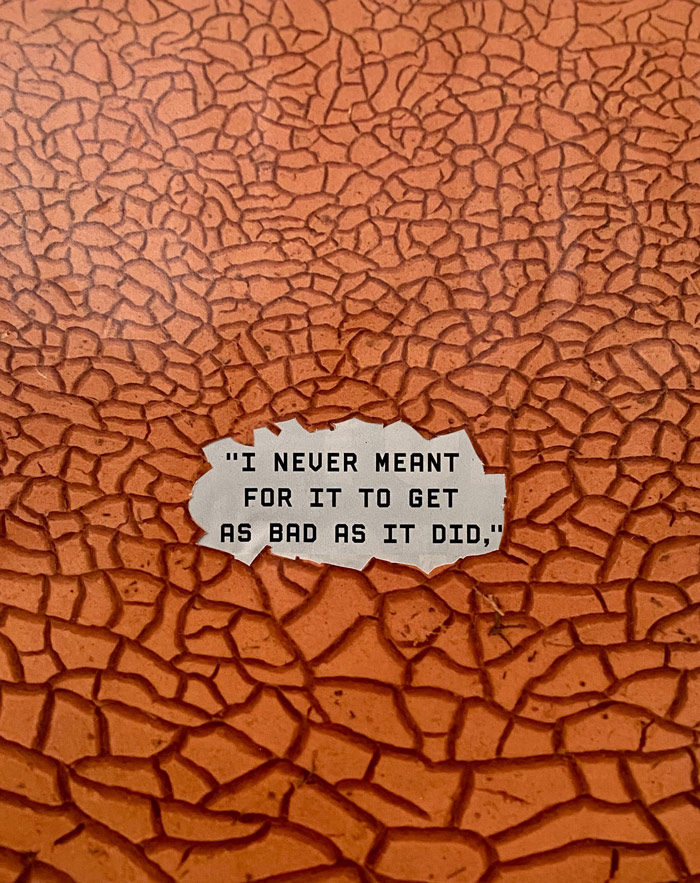
paper collage; 2019. Courtesy of the artist.
Dawnry, (Dawn Conry) is a Phoenix based collage and mixed media artist who crosses the boundary from theatre designer to visual artist. With her artwork, she challenges images, messages, or ideas presented in print format, and imagines a different story. The intention is to let the images speak their own narrative, then work to make it a reality. Working over 20 years among valley theatre companies; she would take one object and transform it into something completely different according to the need of the production. A favorite quote of hers, “I can totally make this look like a dead animal. Does it need to be stiff dead or floppy dead?” She began to realize that such transformations could happen without a need of the purpose of a production, the object could just change. Working in theatre allows for collaboration with a design team to create a single performance production. Collage allows for the same collaboration between print images, design, and art. Such collaborations happen by coincidence, accident, and deliberate effort. In the work she sees the connection of herself to the outer world. Dawnry is especially interested in exploring her own experiences in assisting the process that will create a body of work that speaks to social and political issues.
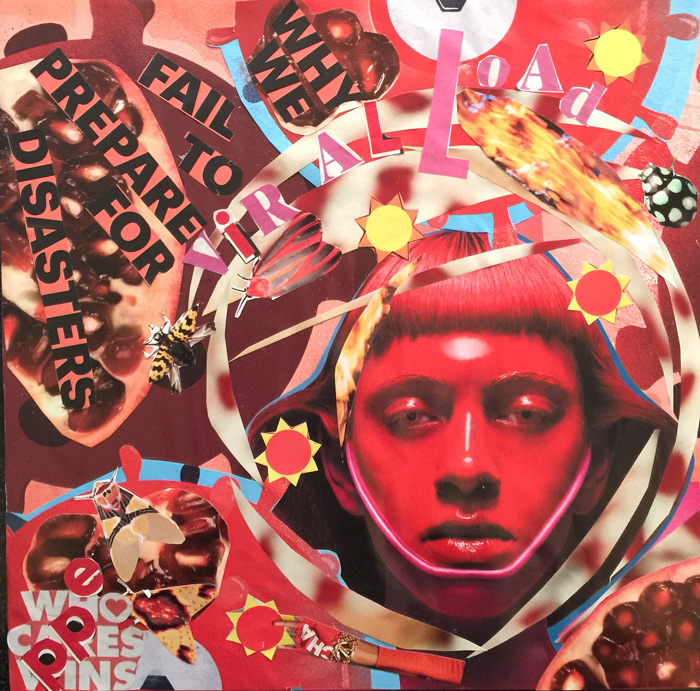
collage; 2020-2021. Courtesy of the artist.
Cathy Greenhalgh is an artist, film-maker (director/cinematographer), lecturer, media anthropologist and writer. She holds a BA in Fine Art from Bath Academy of Art (1979) and an MA in Cinematography and Film Production from the National Film and Television School (UK), (1988). She has over thirty years teaching expertise, most recently as Principal Lecturer in Film and Television at the London College of Communication, University of the Arts London. Cathy spent fifteen years as a professional cinematographer in the film and commercials industries, and has conducted long term ethnographic research with feature film cinematographers and documentary camera people. She directs and shoots ethnographic essay documentaries and art film shorts for cinema, gallery and museum spaces (collaborations with choreographers, animators and
sonic artists). Most recently, she has returned to art practice, principally collage. An exhibition of work produced for Covid Collage Chronicles was shown at the RAI (Royal Anthropological Institute) biannual Film Festival, held in March 2021. She writes on the anthropology of media and visual anthropology; film-making practices and communities of practice, cinematographic phenomena and aesthetics. She has spoken about her collage practice at the RAI/Folklore Society UK in October 2021 and at the Visual Research Conference, USA in November 2021. Cathy received research awards, including ‘Film and Phenomena’, a science-film creative laboratory (UAL Research Fund, 2006 – 2008). She has published several book chapters including ‘Shooting from the Heart : Cinematographers and their Medium’ in Making Pictures : A Century of European Cinematography (2003, Special Commendation Prize, Krasna Krause Moving Image book awards). Cathy’s films have been screened in film festivals worldwide. Aftermath (2006) won first prize Best Experimental Film at Strange Screen Film Festival. She is completing her feature film Cottonopolis, about the legacy of the Manchester cotton trade, shot in England and India. Cathy has retired from working in higher education full-time, but continues on a freelance basis with many projects, paid and unpaid. Cathy lives in London, UK.
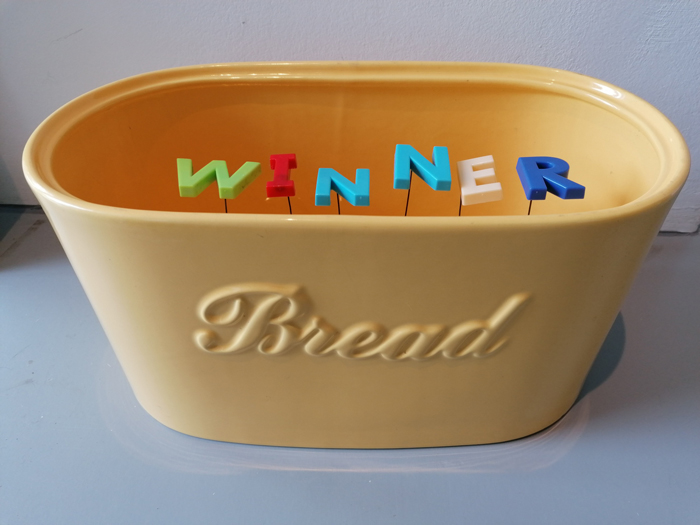
mixed media, ceramic bread bin with plastic letters and wire; 2019. Courtesy of the artist.
Amanda Lynch, UK (b.) 1990, graduated in Fine Art (BA) 2013 at De Montfort University, and graduated in Arts (MA) 2016 at De Montfort University. Lynch has exhibited throughout the UK, and abroad. Residencies include, Gushul artist in residence (Canada) 2016, Ceda artist in residence (UK) 2020,2021, Kolaj Institute’s Oh Money, Money Residency 2021. Lynch has had press features and interviews with Somerset art works, BBC Somerset Radio interviews (2019), ITV feature (Somerset) 2019, 2021, BBC (TV) Somerset 2021. Lynch is currently living and working in Somerset. UK. Lynch is a founding member of the Correspondence Collective, a growing global network of artists collaborating through mail art exchanges.
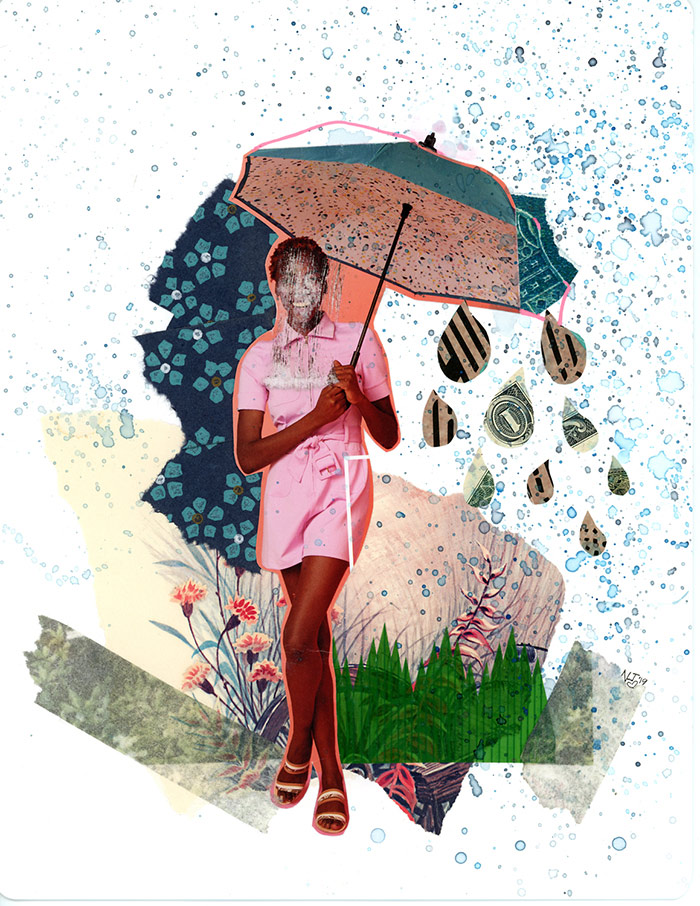
11″x8.5″; mixed media; 2019
Neha Luhar-Trice is an artist living in Jacksonville, FL who holds a Bachelor of Fine Arts degree from the University of Illinois at Chicago. A Midwesterner by birth, relocation to the American Southeast in 2005 profoundly affected Neha’s creative outlook. Though trained as a photographer, her practice has expanded to include mixed-media collage and a mindful doodling technique called Zentangle. Neha’s work has been selected for juried exhibitions nationwide, including shows in San Francisco, CA, Astoria, OR, and multiple appearances in the prestigious Krappy Kamera Exhibition at New York City’s Soho Photo Gallery. She is currently working on a mixed media storybook about cats, incorporating collage and color into the illustrations.
FACULTY
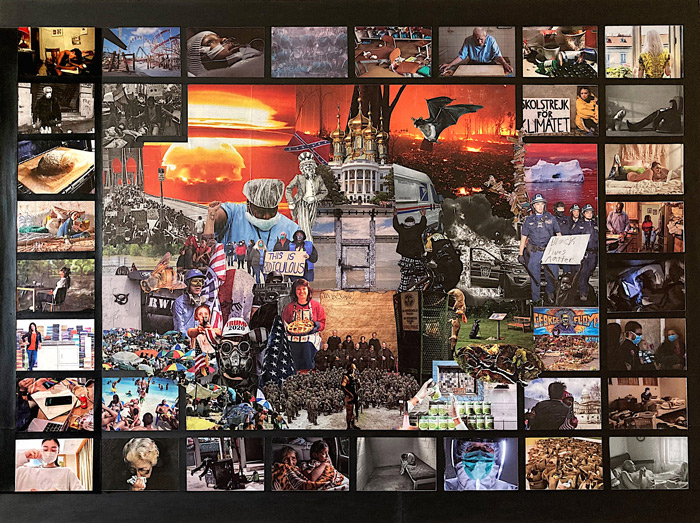
Courtesy of the artist.
G.E. Vogt
G.E. Vogt’s entry into the visual arts stemmed out of her original training as a performance artist and director, highly focused on social and political themes. In order to create the physical performance art she was interested in, she would gather “found” materials from as many arts as possible until the performance pieces became living collages, each telling a visceral story to their audiences. The unique ability of collage to use the juxtaposition of complementary and contradictory elements in order to explore a multi-faceted theme is what drew Vogt to working in collage exclusively. This characteristic of incorporating any medium, material, or found object into telling a complex narrative is what makes it one of the ideal art forms in which to create work about complicated social and political issues. Since 2017, she has exhibited in various group shows across the U.S. In 2019, Fresh Paint Gallery held a major exhibition of Vogt’s work and she spoke on the “Women In Collage” panel at the annual Kolaj Fest New Orleans. Most recently, she has begun curating the SoPoCollage page to showcase other artists who specialize in social & political collage, and participated in Kolaj Institute’s Money Money Collage Residency. Her works have continued to explore many of the themes she has been interested in since her performance work and which have become increasingly relevant – the unmanageable socioeconomic gap, the various forms of inequality prevalent in the U.S, and the toxicity of our political climate.
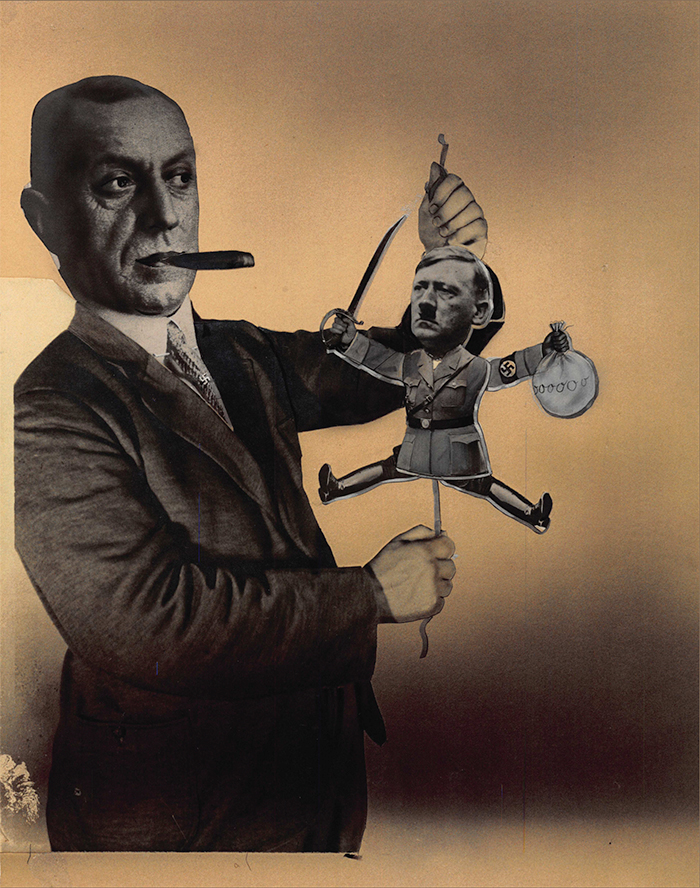
Courtesy of the artist’s estate.
John J Heartfield
Red Burns, the founder of NYU’s multimedia program, described John J Heartfield as “a wonderful blend of the technical and the artistic, a musician with a keen appreciation for the visual arts.” John received a Tisch School of the Arts award “for pioneering work in interactive media.” John is the paternal grandson of the groundbreaking Dada artist and graphic design genius, John Heartfield. With the artist Lance Hansen, John is writing a graphic novel focusing on his grandfather’s cinematic life. The first chapter, The Night the Nazis Came to Murder My Grandfather, appears online and in print in The Nation Magazine (April 12, 2021). A chapter regarding German Dada’s turbulent years will be available soon. An accomplished musician and songwriter, John has brought together a group of brilliant musicians for One Hand!, an upcoming international multimedia event to encourage voter participation. You can find out more about John’s words and music at JohnHeartfield.com. John curates The John Heartfield Exhibition (JohnHeartfieldExhibition.com). In 2009, he built the exhibition to increase his grandfather’s recognition and renown. The Heartfield Exhibition continues to grow beyond the most optimistic expectations. Today, it features world-class contemporary collage artists. Events worldwide ask Professor Heartfield to give his interactive presentation, Art As A Weapon. Audiences are particularly delighted to hear stories about his grandfather’s fascinating personality and anecdotes from when John enjoyed vacations with his grandfather in Europe.
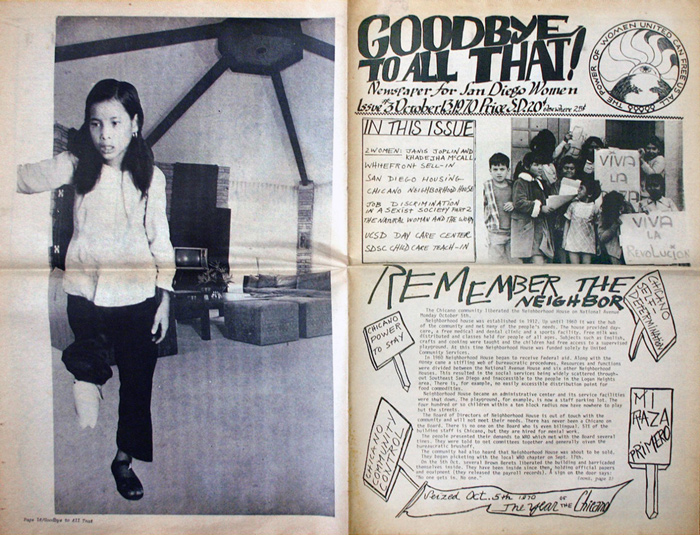
Wendy Ann Parker
Wendy Ann Parker is an art historian currently teaching at Iowa State University. A Vermont native, she moved to the Midwest to do her graduate work at the University of Iowa, home of the International Dada Archives. Wendy’s research is centered on activist art, and her MA Thesis examined the political collage/photomontage work of Dada artists including John Heartfield, Hannah Höch, Raoul Hausmann, and Kurt Schwitters. She is currently finishing a doctoral dissertation focusing on more contemporary artists, particularly Martha Rosler. Wendy is especially interested in how activist artists reach their intended audiences and feels that in today’s culture of visual sophistication, collage is arguably the most potent medium for communicating those messages.
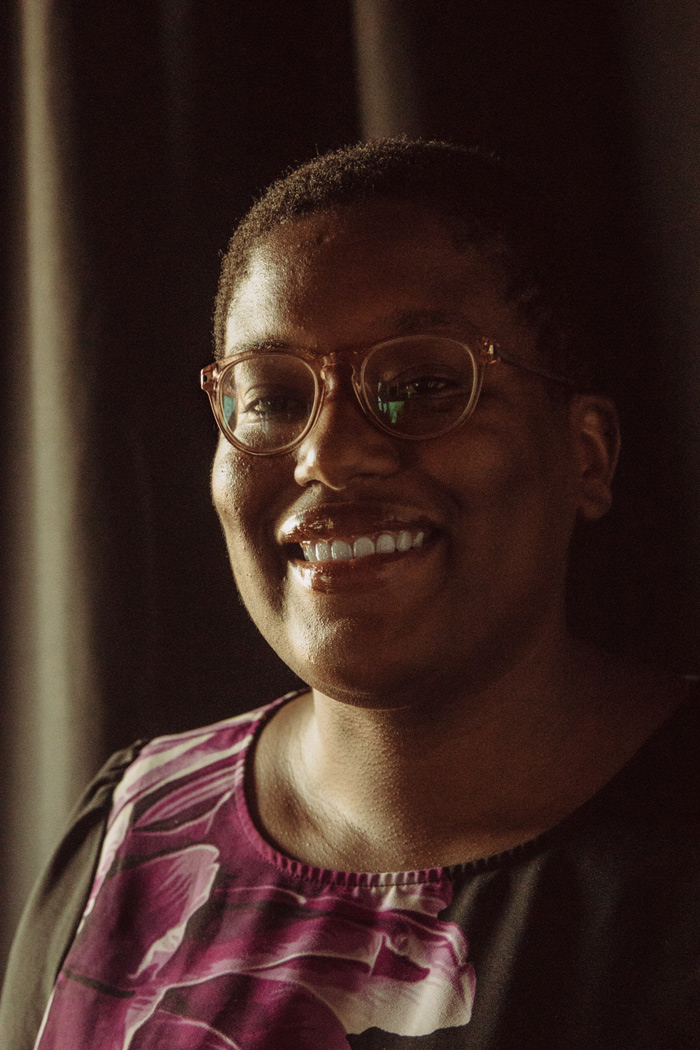
Teri Henderson
Teri Henderson is a Baltimore based independent curator, staff writer, and the founding director of the Black Collagists Arts Incubator. Henderson holds a Bachelor of Science in Psychology from Texas Christian University. She formerly held a curatorial internship at Ghost Gallery in Seattle, Washington. Henderson previously served as the Art Law Clinic Director for Maryland Volunteer Lawyers For The Art and is currently on their board of directors. Her written work has been seen in: All SHE Makes, Justsmile Magazine, Kinfolk Travel, and the St. James Encyclopedia of Hip Hop Culture. Her work as co-director of WDLY addresses shrinking the gap between the spaces that contemporary artists of color inhabit and the resources of the power structures of the art world through the curation and artistic production of events. She is also the Gallery Coordinator for Connect + Collect Gallery. In her work as a staff writer for BmoreArt she highlights the voices of Black, brown, queer and non-traditional artists and creatives. In the Fall of 2020 Henderson started Black Collagists, an arts incubator designed to research and collect the work of Black collage artists internationally.
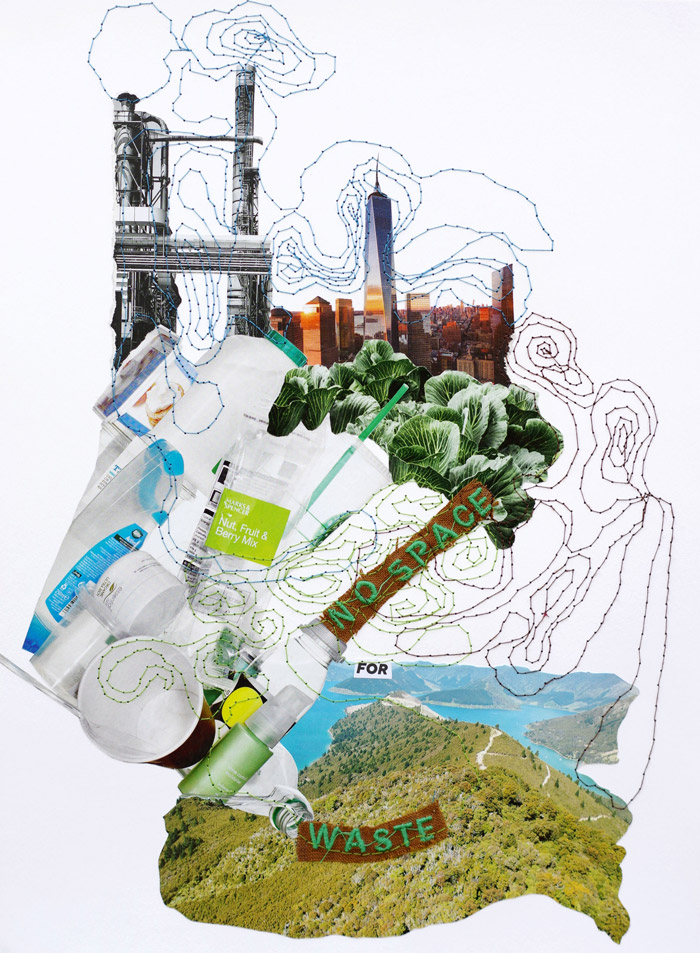
Courtesy of the artist.
Liucija Dervinytė
Liucija Dervinytė, currently living in Vilnius, Lithuania, is a visual artist and culture manager, a co-founder of Ideas Block cultural organisation and Arttice digital cultural networking platform. She studied visual arts and painting in M.K.Čiurlionis Art School in Vilnius, and received her BA in Textiles from The University of Edinburgh. Through her creative practices Liucija explores the field of sustainability and the role of arts, culture and community in supporting the exchange of ideas and knowledge, raising awareness of human impact on the ecosystems, current environmental, social and political issues. Liucija’s artworks are inspired by natural structures and the ideas of interconnectedness. She works with collage, watercolor and embroidery. Sometimes these techniques intertwine or are used separately, informing one another and expanding on the similar ideas or visions. In addition, her collages become covers for her handmade notebooks and embroidery is used in refashioning second-hand clothing.
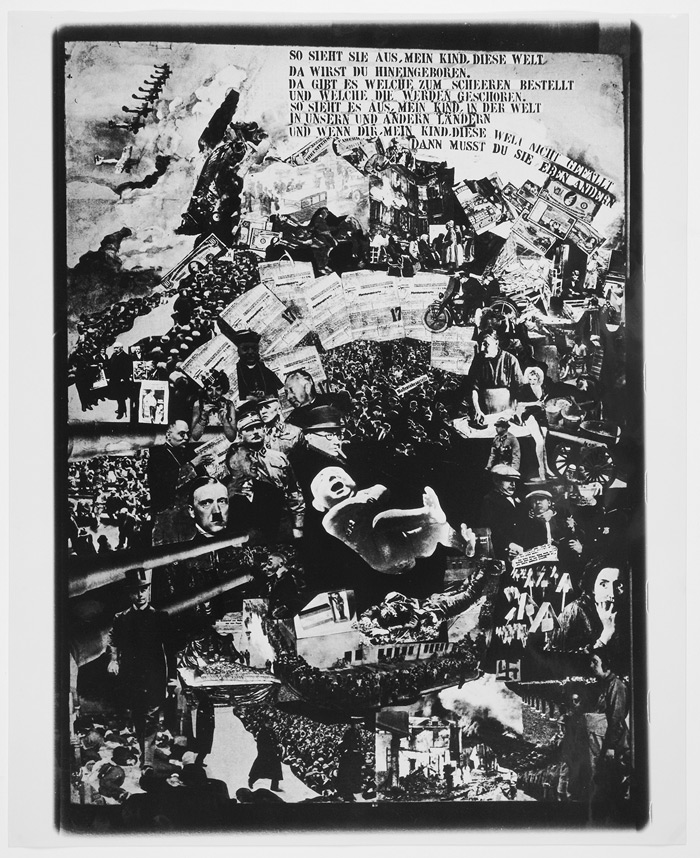
photo of photo collage; 1933. Image courtesy of mumok.at.
Ginger Sedlarova
Ginger Sedlarova considers herself both a collage artist and a storyteller. Sometimes her work is a short story, sometimes it’s a novel. But it’s always surreal, full of observations about the absurdity of daily life or conversations with the cities she’s lived in, visited and loved. Her practice grew from her love of making photo collages in her former career as a graphic artist on daily newspapers in Canada and on magazines in Central Europe. She first discovered Friedl Dicker-Brandeis’ collages at a show of German and Austrian art of the 1930s at the Neue Gallery in New York and was in awe of Dicker-Brandeis’ use of composition and imagery and her bravery. A Beatlemaniac, Sedlarova lives in Burnaby, British Columbia with her husband and two rescue cats. Her work has appeared in galleries and online shows in Canada, the U.S. and Europe.
ORGANIZERS
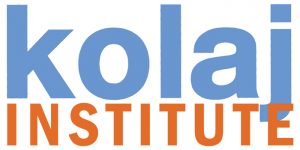
ABOUT KOLAJ INSTITUTE
The mission of Kolaj Institute is to support artists, curators, and writers who seek to study, document, & disseminate ideas that deepen our understanding of collage as a medium, a genre, a community, and a 21st century movement. We operate a number of initiatives meant to bring together community, investigate critical issues, and raise collage’s standing in the art world. WEBSITE
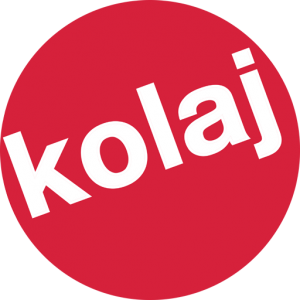
ABOUT KOLAJ MAGAZINE
Kolaj Magazine is a quarterly, printed, art magazine reviewing and surveying contemporary collage with an international perspective. We are interested in collage as a medium, a genre, a community, and a 21st century art movement. WEBSITE
